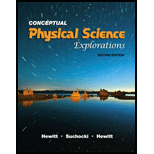
What is an alloy?
The detail about the materials called an alloy.
Answer to Problem 12RQ
An alloy is a combined form of number of metallic elements.
Explanation of Solution
The elements in a periodic table are broadly classified into two main parts; those are metals and non-metals.
The metals are the elements having good electrical and heat conductivity. But some metals are soft in nature in their pure form.
Thus the pure metals are mixed with some other element and the combined product is formed with some distinct nature with an enhanced physical nature than that of pure metal. The product so formed by the combination of two or more metals is called an alloy.
Conclusion:
Thus, an alloy is a mixture composed of two or more metallic elements composed to enhance the physical nature of a pure metal.
Chapter 18 Solutions
Conceptual Physical Science Explorations
Additional Science Textbook Solutions
Essential University Physics: Volume 2 (3rd Edition)
An Introduction to Thermal Physics
Modern Physics
The Cosmic Perspective (8th Edition)
College Physics: A Strategic Approach (4th Edition)
Tutorials in Introductory Physics
 College PhysicsPhysicsISBN:9781305952300Author:Raymond A. Serway, Chris VuillePublisher:Cengage Learning
College PhysicsPhysicsISBN:9781305952300Author:Raymond A. Serway, Chris VuillePublisher:Cengage Learning University Physics (14th Edition)PhysicsISBN:9780133969290Author:Hugh D. Young, Roger A. FreedmanPublisher:PEARSON
University Physics (14th Edition)PhysicsISBN:9780133969290Author:Hugh D. Young, Roger A. FreedmanPublisher:PEARSON Introduction To Quantum MechanicsPhysicsISBN:9781107189638Author:Griffiths, David J., Schroeter, Darrell F.Publisher:Cambridge University Press
Introduction To Quantum MechanicsPhysicsISBN:9781107189638Author:Griffiths, David J., Schroeter, Darrell F.Publisher:Cambridge University Press Physics for Scientists and EngineersPhysicsISBN:9781337553278Author:Raymond A. Serway, John W. JewettPublisher:Cengage Learning
Physics for Scientists and EngineersPhysicsISBN:9781337553278Author:Raymond A. Serway, John W. JewettPublisher:Cengage Learning Lecture- Tutorials for Introductory AstronomyPhysicsISBN:9780321820464Author:Edward E. Prather, Tim P. Slater, Jeff P. Adams, Gina BrissendenPublisher:Addison-Wesley
Lecture- Tutorials for Introductory AstronomyPhysicsISBN:9780321820464Author:Edward E. Prather, Tim P. Slater, Jeff P. Adams, Gina BrissendenPublisher:Addison-Wesley College Physics: A Strategic Approach (4th Editio...PhysicsISBN:9780134609034Author:Randall D. Knight (Professor Emeritus), Brian Jones, Stuart FieldPublisher:PEARSON
College Physics: A Strategic Approach (4th Editio...PhysicsISBN:9780134609034Author:Randall D. Knight (Professor Emeritus), Brian Jones, Stuart FieldPublisher:PEARSON





